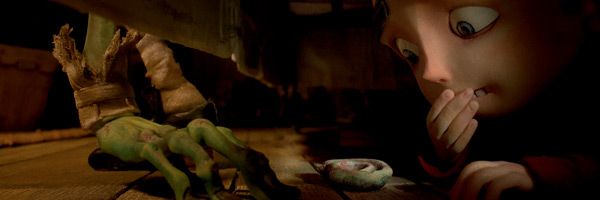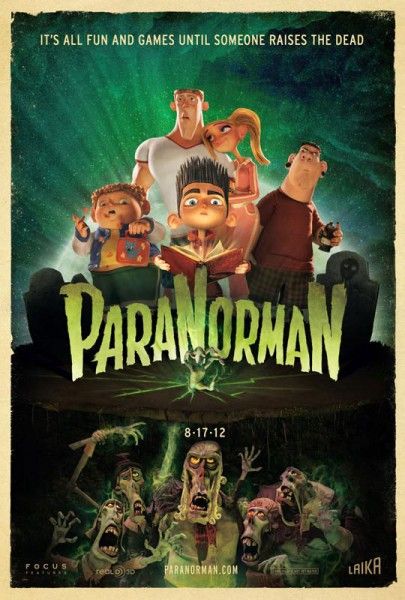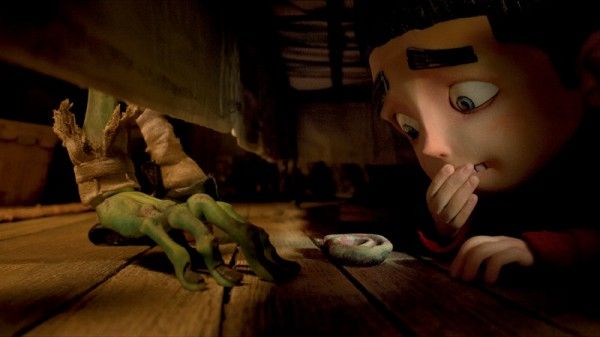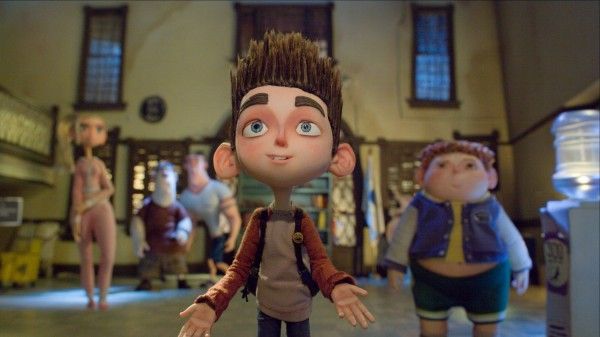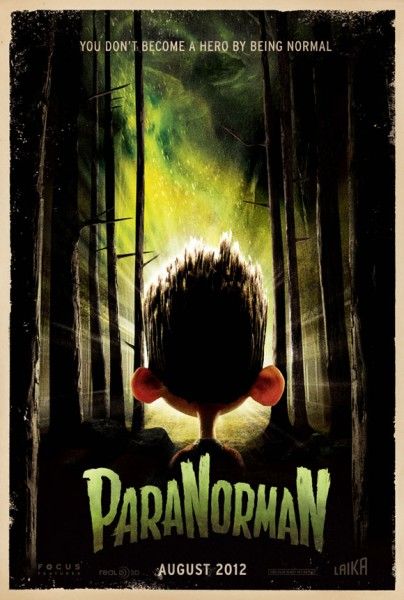In the middle of February, I was able to visit LAIKA Studios in Hillsboro, Oregon to get an early look at their upcoming 3D stop-motion movie ParaNorman. As a big stop-motion fan, it was incredibly cool to get a behind-the-scenes look at how it all comes together, and to see where they made their last film, Coraline. While I assumed the process of making a stop-motion movie doesn't change, when I visited LAIKA I learned that new technology is helping to make ParaNorman one of the most technically advanced stop-motion movies ever made, and some of what they're using is straight out of an episode of Star Trek. And the best part: the technology will soon be in everyone's homes! Hit the jump for more.
Before going any further, if you haven't seen the trailer for director Sam Fell and Chris Butler's ParaNorman, I'd watch that first. The voices you'll hear are Casey Affleck, Tempestt Bledsoe, Alex Borstein, Jodelle Ferland, Bernard Hill, John Goodman, Anna Kendrick, Leslie Mann, Christopher Mintz-Plasse, Kodi Smit-McPhee, and Elaine Stritch. Here's the synopsis:
In ParaNorman, a small town comes under siege by zombies. Who can it call? Only misunderstood local boy Norman, who is able to speak with the dead. In addition to the zombies, he’ll have to take on ghosts, witches and, worst, of all, grown-ups, to save his town from a centuries-old curse. But this young ghoul whisperer may find his paranormal activities pushed to their otherworldly limits.
As most of you know, whenever I do a set visit with Peter from Slashfilm, we record a video blog as soon as we get back. However, since we visited LAIKA on separate days, we recorded our video blog over Skype a few days ago. While we talked about all the usual stuff, the best part was geeking out over 3D printing. Trust me, when you start to learn more about 3D printing, you're going to want a 3D printer immediately.
35 Things to Know About ParaNorman
- The way the film was described to us, it's John Carpenter meets John Hughes. It's a zombie movie for kids.
- All production on ParaNorman took place at the LAIKA Studios located in Hillsboro, Oregon, in a 151,140 square foot building space. With a crew of over 320 designers, artists, animators and technicians, there were 52 separate shooting units working at almost any given time during the shoot.
- ParaNorman is the first stop-motion movie to utilize a 3D Color Printer to create replacement faces for its puppets. Over 31,000 individual facial parts were printed for the production.
- It took 60 puppet makers to create 178 individual puppets for ParaNorman. Thanks to the face replacement technology created by the 3D Color Printer, Norman has about 8,000 faces with a range of individual pieces of brows and mouths allowing him to have approximately 1.5 million possible facial expressions.
- There are 275 spikes in Norman’s signature hair style. His hair was primarily made out of goat hair held together with hot glue, hair gel, fabric, and super glue – as well as medical adhesive, Pros-Aide make-up adhesive, thread, and wire. Once built, it was hand-finished with paint and human hair dye.
- 120 different costumes were designed and created for ParaNorman.
- Norman is 9 and 3/4 inches tall. The largest character is 13 inches.
- Norman has more facial expressions that a human. He has 19 joints and each one has a few parts.
- During a big van chase, they reduced everything down by 50% (vehicles, figures, etc.) to make it easier to film
- The film has 40 individual characters. For the main character Norman, they made 28 of them to work with. For the 9 to 12 other main characters, they made around 10 of each of them. For some of the characters that are barely in the film, they only made one version.
- Due to the constant damage that happens while filming, the crew that made the characters stays on the entire time to fix problems and repair broken limbs.
- It took 18 carpenters, 18 model builders, 6 riggers, 12 scenic painters, 11 greens artists, and 10 set dressers to create some three dozen unique locations for ParaNorman.
- The crew of 93 artists in the ParaNorman art department used over 4,000 pounds of silicone for prop and set fabrication.
- The bottom edge of Norman’s T-shirt has 102 stitches – all handmade and measured in length and spacing – with 48 stitches around his neckline.
- The bathroom sequence, when Norman is contacted by the ghost of Mr. Prenderghast, took a whole year to shoot.
- The model shop made 26 “animatable” (meaning, with moving parts) vehicles. All were actually able to roll forward and backward, and most of them also had working headlamps, windows, and taillights.
- Rapid Prototyping (3D printing) is straight out of Star Trek. Imagine a printer that can print real objects. This technology will change the way planes are manufactured so instead of using hundreds of small parts, imagine a large printer that could print an entire wing or fuselage. For ParaNorman, they are using the technology to help make some of the pieces of Norman and other objects being used in the film. Norman has 78 pieces that were created in the computer. Also, in the future, you'll be able to download a file that someone else created and print it up on your 3D printer!
- The 3D printers that were using cost around 50 thousand dollars each. And while that's expensive, that doesn't factor in the replacement resin costs. Like all printers, it's the ink that gets you. Replacement resin bags are $400 to $900 each. They're also not that big so it gets expensive quick.
- Rapid Prototyping was first developed by the military then fortune 500 companies started using them. NASA might have been the first to use the technology. From what I understand, they had files of every part on the shuttle and they could print up whatever they needed if something broke. Rapid Prototyping can print in metal and other materials.
- By combining stop-motion with CGI, the characters can now emote like other animated movies. Character faces were the Achilles heel of stop-motion.
- An animator and a "facial animation specialist" work together so an animator can just focus on the animation and not what facial piece is needed. The "facial animation specialist" breaks down the frames and says what face and eyebrow is needed in each frame.
- 2/3 of the movie takes place outdoors.
- All the locations are based on real world places. The directors and the some of the team went to New England and took a lot of pictures.
- All the sets we were shown (the Blithe Middle School, the Post Office, Mr. P's house, Town Square) are very angular. They described the sets as heightened naturalism.
- They knew the ending before they started writing, so they always knew where they were going.
- The directors were influenced by Ghostbusters, The Goonies, E.T. and other Amblin films of the 80s.
- They storyboarded the entire movie before filming began.
- There is a big action set piece in the 2nd act that's very ambitious because of the length. Typical stop-motion action scenes are short and they usually don't have a lot of characters. ParaNorman is going for something special with this scene. Also, they have a scene in the film with 15 characters.
- A typical animator does 3 to 5 seconds of film a week. A fast animator can do 10 seconds but it also depends on what they're animating. Some sequences are easier than others.
- While you might think they're filming with a special camera, the production is shooting with the Canon 5D which you can buy at BestBuy or other local electronic stores. However, they are using Nikon lenses that aren't made anymore. We were told there is a huge demand for the lenses. Aardman Animation used some of the lenses on The Pirates! and the Nikon lenses have become the industry standard for stop-motion films.
- Typically an animator will do a rehearsal for the director. A rehearsal in stop-motion means they will animate the scene but only use half the frames so the director can see what they're going to do.
- They're using an Xbox Kinect in some scenes to help map the 3D space.
- The scene of Norman in a bright green forest with a girl is using 7 cameras to shoot the scene and the Xbox Kinect. It's a big VFX shot.
- We were told the movie has a different tone than Coraline because we'll see the full range of human emotions.
- All the lead characters use replacement technology. The background characters use mechanical technology. Replacement technology is more expensive.
- The film has a shot that is 40 seconds long. It took the animator 6 weeks to do it.
Finally, here's a bunch of behind-the-scenes images from LAIKA and some movie images:

